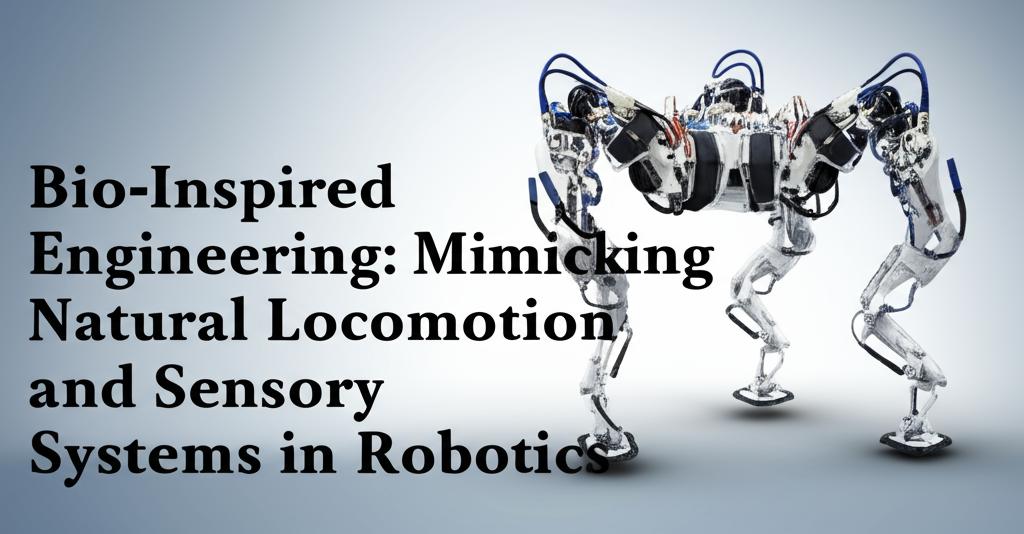Nature has long been the ultimate innovator, and engineers are increasingly turning to the biological world for inspiration in creating the next generation of robots. This approach, known as bio-inspired engineering, focuses on mimicking the remarkable locomotion and sensory systems found in animals and plants to develop robots that are more agile, adaptable, and efficient.
Emulating Nature's Movement:A primary focus of bio-inspired robotics is to replicate the diverse and often complex ways animals move. Scientists and engineers are studying everything from the undulation of snakes and fish to the legged locomotion of insects and mammals, and the flight of birds and insects.
- Agility and Terrain Adaptation: Robots inspired by animals demonstrate enhanced abilities to navigate challenging environments. For instance, legged robots, modeled after creatures like dogs or goats, can traverse uneven terrain, climb stairs, and overcome obstacles that would be impassable for wheeled robots. This is achieved by understanding and replicating the biomechanics of animal limbs, including joint orientation and hoof/foot design for stability.
- Multimodal Locomotion: Some of the most exciting advancements are in robots capable of multiple modes of movement, similar to amphibious animals. Robots like the "Salamandra robotica II" can operate on both land and in water, opening up new possibilities for environmental monitoring and conservation efforts where ecosystems interconnect.
- Soft Robotics: Drawing inspiration from biological tissues and soft-bodied organisms like octopuses or elephant trunks, soft robotics is a rapidly growing subfield. These robots, made from compliant materials, offer greater flexibility, safety in human-robot interaction, and the potential to navigate confined or delicate spaces. Researchers are actively developing new soft materials that more closely mimic biological tissues.
- Aerial Maneuverability: Bird and insect flight provides a rich blueprint for developing unmanned aerial vehicles (UAVs) with exceptional maneuverability. Flapping-wing drones, for example, aim to replicate the lift and thrust generation of birds, potentially offering quieter and more agile flight for applications like surveillance and monitoring.
- Swarm Robotics: Inspired by the collective behavior of social insects like ants or bees, swarm robotics involves coordinating large numbers of relatively simple robots to perform complex tasks. This approach offers robustness and scalability for applications ranging from exploration to construction.
Beyond movement, bio-inspired design is revolutionizing robotic sensory systems, enabling robots to perceive and interact with their surroundings in more sophisticated ways.
- Advanced Vision Systems: Engineers are developing vision systems that emulate the compound eyes of insects for wider fields of view or mimic the visual processing capabilities of animals for improved object recognition and navigation in cluttered environments.
- Tactile Sensing: Replicating the sense of touch is crucial for tasks requiring dexterous manipulation and safe interaction. Bio-inspired tactile sensors, sometimes based on the mechanoreceptors in skin or the sensory abilities of octopus arms, allow robots to discern texture, pressure, and slippage. Novel neuromorphic vision-based tactile sensors are even emerging, using event-based cameras to rapidly capture and convey interaction information.
- Auditory and Olfactory Sensing: Developments include artificial bio-inspired sound sensors that can outperform human hearing, particularly useful for underwater navigation where GPS is unavailable. Olfactory sensors are also being explored to detect chemicals and odors, mimicking animal abilities for tasks like search and rescue or environmental monitoring.
- Proprioception: Just as animals have an innate sense of their body position and movement, robots are being equipped with proprioceptive sensors to understand their own configuration, leading to improved balance and coordination.
- Neuromorphic Computing and Control: Researchers are increasingly integrating brain-inspired computing, such as neuromorphic chips and Central Pattern Generators (CPGs), into robotic control systems. CPGs, for instance, can create rhythmic motions for locomotion more autonomously and energy-efficiently, mimicking the neural circuits in animal spinal cords. This allows robots to process sensory data and control movement in a way that is more akin to biological systems, leading to better adaptability and learning.
Despite significant progress, several challenges remain in the field of bio-inspired robotics:
- Energy Efficiency: Replicating the energy efficiency of biological systems is a major hurdle. Current battery technology and power transmission often limit the operational duration and capabilities of autonomous robots.
- Sensor Integration and Processing: Effectively integrating a diverse array of sensors and processing the vast amounts of data they generate to achieve animal-like environmental interpretation requires further advancements in sensor technology and data processing algorithms.
- Material Durability: Soft robotics, while offering many advantages, faces challenges with material wear and tear, especially in demanding environments.
- Complexity of Biological Systems: Nature's designs are incredibly intricate, honed over millions of years of evolution. Fully understanding and replicating this complexity, from musculoskeletal systems to neural control, remains a long-term endeavor.
- Achieving True Autonomy: While many bio-inspired robots demonstrate impressive capabilities, achieving full autonomy in control, energy management, and decision-making, particularly in unpredictable environments, is an ongoing pursuit.
The fusion of biology, engineering, materials science, and artificial intelligence continues to drive innovation in bio-inspired robotics. Future advancements are expected in areas like:
- Enhanced Soft Actuators and Materials: Creating materials that can more closely mimic the functionality and adaptability of biological muscle and tissue.
- More Sophisticated AI and Machine Learning: Developing AI that allows robots to learn and adapt their locomotion and sensory strategies in real-time, similar to animals.
- Robotic Paleontology: Using robotic models to study the locomotion of extinct animals, providing insights into evolutionary biology.
- Applications in Diverse Fields: Expanding the use of bio-inspired robots in areas such as search and rescue, environmental monitoring and conservation, medical applications (including prosthetics and soft robots for surgery), deep-sea and space exploration, and manufacturing.
By continuing to draw inspiration from the ingenious solutions found in nature, researchers are paving the way for robots that are not only more capable but also better integrated and more harmonious with the natural world. This interdisciplinary approach promises a future where robots can tackle complex challenges and contribute to sustainable development in ways previously unimagined.

